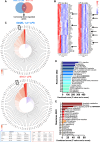Mitochondrial respiratory complex III sustains IL-10 production in activated macrophages and promotes tumor-mediated immune evasion
- PMID: 39841829
- PMCID: PMC11789823
- DOI: 10.1126/sciadv.adq7307
Mitochondrial respiratory complex III sustains IL-10 production in activated macrophages and promotes tumor-mediated immune evasion
Abstract
The cytokine interleukin-10 (IL-10) limits the immune response and promotes resolution of acute inflammation. Because of its immunosuppressive effects, IL-10 up-regulation is a common feature of tumor progression and metastasis. Recently, IL-10 regulation has been shown to depend on mitochondria and redox-sensitive signals. We have found that Suppressor of site IIIQo Electron Leak 1.2 (S3QEL 1.2), a specific inhibitor of reactive oxygen species (ROS) production from mitochondrial complex III, and myxothiazol, a complex III inhibitor, decrease IL-10 in lipopolysaccharide (LPS)-activated macrophages. IL-10 down-regulation is likely to be mediated by suppression of c-Fos, which is a subunit of activator protein 1 (AP1), a transcription factor required for IL-10 gene expression. S3QEL 1.2 impairs IL-10 production in vivo after LPS challenge and promotes the survival of mice bearing B16F10 melanoma by lowering tumor growth. Our data identify a link between complex III-dependent ROS generation and IL-10 production in macrophages, the targeting of which could have potential in boosting antitumor immunity.
Figures





References
-
- Saraiva M., O’Garra A., The regulation of IL-10 production by immune cells. Nat. Rev. Immunol. 10, 170–181 (2010). - PubMed
MeSH terms
Substances
LinkOut - more resources
Full Text Sources
Other Literature Sources
Research Materials

